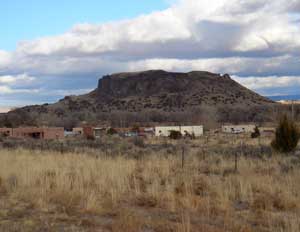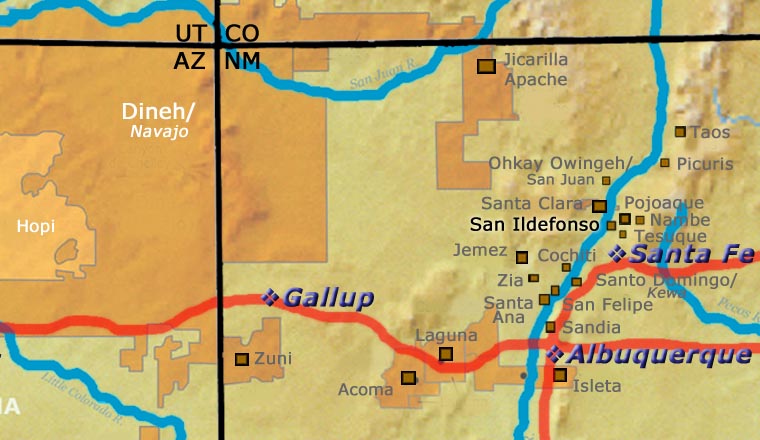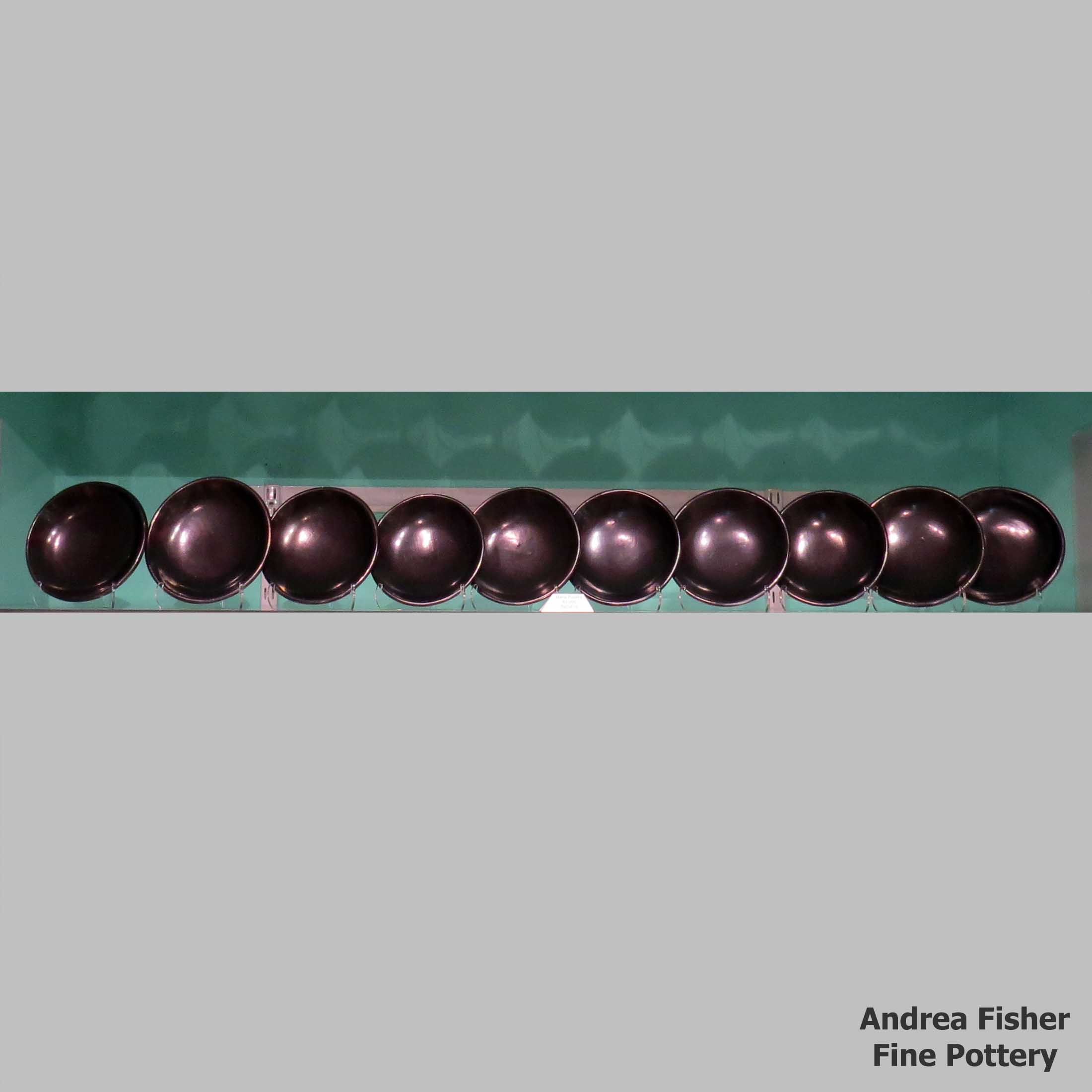
Maria Martinez
San Ildefonso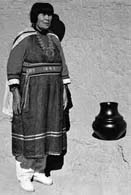
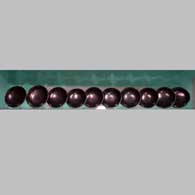
Undoubtedly the world's most famous Native American potter, Maria Montoya Martinez was born in the Tewa pueblo of San Ildefonso around 1887 (her baptism certificate says 1887, she herself thought she might have been 7 at the time). As she grew up, Maria observed her aunt, Nicolasa, and learned the basics of the traditional art of pottery making from her. In the early years of her career, Maria produced the traditional polychrome pottery of her village, generally black and terra cotta decorations painted on a background of white or tan. She shaped her pots the age-old way, by carefully hand-coiling and pinching the clay, then smoothing the inner and outer surfaces with gourd scrapers. Early on her pots were recognized as the thinnest, most beautifully shaped pots being made at San Ildefonso. Her husband, Julian, an accomplished painter of hides, paper and walls, decorated the pots for her, then worked with her in the firing of them.
Maria and Julian were married in 1904 and almost from the beginning of their relationship they were traveling to demonstrate their craft at various fairs and expositions. They spent their honeymoon in 1904 demonstrating pottery making at the Louisiana Purchase Exhibition at the St. Louis Worlds Fair. They demonstrated again at the Panama California Expo in San Diego in 1915, the Chicago Worlds Fair in 1934, and the Golden Gate International Expo in 1939. Native American craft fairs provided other marketing opportunities, and by signing her work Maria both heightened her visibility and commanded higher prices. In 1954, she won the Craftsmanship Medal, the nation's highest honor, from the American Institute of Architects.
Contrary to legend implying that Maria "discovered" the black pottery process, Dr. Edgar Lee Hewett, Professor of Archaeology at the University of New Mexico in Albuquerque and Director of the Museum of New Mexico in Santa Fe, found shards of prehistoric black pottery while excavating in the ruins at Bandelier National Monument in 1908. To preserve and showcase that ancient product Hewett sought a skilled pueblo potter who could re-create that ancient pottery style for him. Everyone he asked referred him to Maria. Together they worked out a deal and he pre-ordered a series of black-on-black pots from her. That led to more than a decade of experimentation, until Maria and Julian were satisfied with their results in recreating that style of black ware. Their method required smothering the fire with manure during the firing process, effectively creating an "oxygen-reduction process" that turned the red pots black. Julian worked out the other half of the "black-on-black" process when he began painting his designs "in the negative," using a matte black slip on the polished pot surface to create his decorations. Once fired, that demonstrated the technique that has become so famous today. Still, Maria wasn't really happy with those first black-on-black pots until Hewett came to visit with some friends and students of his. Those visitors bought virtually every pot Maria had on hand and they encouraged her to make more. Maria responded by refining her process and technique with the clay and the fire. Julian responded by refining his designs and decorations. Together they elevated their art to a level not approached anywhere else for at least 10 years.
According to Susan Peterson in The Living Tradition of Maria Martinez, the six distinct steps involved in the creation of blackware pottery include, "finding and collecting the clay, forming a pot, scraping and sanding the pot to remove surface irregularities, applying the iron-bearing slip and burnishing it to a high sheen with a smooth stone, decorating the pot with another slip, and firing the pot."
Julian faced a challenge in attempting to decorate Maria's pots. The process he finally settled on involved polishing the background first and then applying the matte slip decoration. In 1918, Julian finished the first decorated black ware pot with a matte background and a polished avanyu (horned water serpent) design. Many of Julian's decorations were patterns adopted from ancient vessels of the Pueblos. Some of the patterns consisted of feathers, birds, road runner tracks, rain, clouds, mountains, and zigzags or kiva steps.
As her pots attracted more and more attention for their unique beauty, Maria began to charge modest prices. With the demand for her pots growing, she realized that her work could enrich the lives of the people of her pueblo, artistically and economically. In the ages-old tribal manner, she generously shared her techniques with others. Martinez was the matriarch of a "craft lineage" that continues today. In a career that spanned seven decades, her pottery brought honors and acclaim, revitalizing the art and the economy of San Ildefonso Pueblo.
Even though Julian decorated the pots, Maria claimed all the work in the early years because pottery was still considered a woman's job in the Pueblo. Maria left Julian's signature off their pieces to respect the Pueblo culture until 1925. After that, "Marie + Julian" was the official signature on their decorated pottery until Julian's death in 1943 (and she used "Marie" because Chester Faris, Director of the Santa Fe Indian School, had convinced her that was a name more familiar to the Anglo buying public). Undecorated pots during those years were signed simply "Marie." Maria's family began helping more with the pottery business after Julian's death. From 1943 to 1956 Maria's son Adam took over collecting clay while his wife Santana took over painting decorations. "Marie + Santana" was the signature on their pots. Popovi Da began learning to paint with Santana in 1950 and in 1956 he took over doing most of Maria's painting. The signature became "Maria/Popovi" until 1971 when Popovi passed on. He'd also often been busy with tribal politics during those years and, at times, couldn't keep up with painting Maria's pots. As Maria almost never painted a pot, those pots are plain and signed "Maria Poveka" (Poveka being her Tewa name, meaning: "pond lily"). Today, values on Maria's work vary based on the signature on the bottom, those with "Maria + Popovi" being valued highest.
After making pots for almost 80 years, Maria passed on in 1980.
100 West San Francisco Street, Santa Fe, New Mexico 87501
(505) 986-1234 - www.andreafisherpottery.com - All Rights Reserved

San Ildefonso Pueblo
San Ildefonso Pueblo is located about twenty miles northwest of Santa Fe, New Mexico, mostly on the eastern bank of the Rio Grande. Although their ancestry has been traced to prehistoric pueblos in the Mesa Verde area, their most recent ancestral home is in the area of Bandelier National Monument, the prehistoric village of Tsankawi in particular. Tsankawi abuts the reservation on its northwest side.
A mission church was built in 1617 and named for San Ildefonso. Hence the name. Before that the village was called Powhoge, "where the water cuts through" (in Tewa). Today's pueblo was established as long ago as the 1300s. When the Spanish arrived in 1540, they estimated the village population at about 2,000.
That mission was destroyed during the Pueblo Revolt of 1680 and when Don Diego de Vargas returned to reclaim the San Ildefonso area in 1694, he found virtually all the Tewa people on top of nearby Black Mesa. After an extended siege the two sides negotiated a treaty and the people returned to their villages. However, the next 250 years were not good for them. The Spanish swine flu pandemic of 1918 reduced the pueblo's population to about 90. Their population has grown to more than 600 now but the only economic activity available on the pueblo involves creating art in one form or another. The only other work is off-pueblo. San Ildefonso's population is small compared to neighboring Santa Clara Pueblo, but the pueblo maintains its own religious traditions and ceremonial feast days.
San Ildefonso is most known for being the home of the most famous Pueblo Indian potter, Maria Martinez. Many other excellent potters from this pueblo have produced quality pottery, too, among them: Blue Corn, Tonita and Juan Roybal, Dora Tse Pe and Rose Gonzales. Of course the descendants of Maria Martinez are still important pillars of San Ildefonso's pottery tradition. Maria's influence reached far and wide, so far and wide that even Juan Quezada of the Mata Ortiz pottery renaissance in Chihuahua, Mexico, came to San Ildefonso to learn from her.
100 West San Francisco Street, Santa Fe, New Mexico 87501
(505) 986-1234 - www.andreafisherpottery.com - All Rights Reserved

San Ildefonso
$ 5000
agsih7070
Set of 10 plain black plates
1.25 in H by 6.25 in Dia
Condition: Fair
Signature: Maria Poveka
Date Created: 1956-1971
100 West San Francisco Street, Santa Fe, New Mexico 87501
(505) 986-1234 - www.andreafisherpottery.com - All Rights Reserved

Maria Martinez Family Tree
Disclaimer: This "family tree" is a best effort on our part to determine who the potters are in this family and arrange them in a generational order. The general information available is questionable so we have tried to show each of these diagrams to living members of each family to get their input and approval, too. This diagram is subject to change should we get better info.
- Cipriana Peña (c. 1810-)
- Santana Peña (1846-) & Antonio Domingo Peña (1841-)
- Nicolasa Peña Montoya (1863-1904) & Juan Cruz Montoya
- Tonita Martinez Roybal (1892-1945) & Alfredo Montoya
- Isabel Montoya (1898-1996) & Benjamin Atencio
- Angelita Atencio Sanchez (1927-1993) & Santiago Sanchez
- Sandra Sanchez Chaparro
- Gilbert Atencio (1930-1995)
- Tony Atencio (1928-)
- Helen Gutierrez (1935-1993) & Frank Gutierrez (Santa Clara)
- Carol & James Gutierrez
- Kathy Gutierrez Naranjo & Ernest J. Naranjo
- Rose Gutierrez
- Geraldine Gutierrez Shije (1959-)
- Angelita Atencio Sanchez (1927-1993) & Santiago Sanchez
- Rayita Montoya
- Santana Montoya & Antonio Vigil
- Lupita Vigil Martinez (1918-2006) & Anselmo Martinez (1909-1965)
- Reyes Peña (d. 1909) & Tomas Montoya (d. 1914)
- Desideria Montoya (1889-1982)
- Maria Montoya Martinez (1887-1980) & Julian Martinez (1884-1943)
- Adam Martinez (1903-2000) and Santana Roybal Martinez (1909-2002)
- George Martinez (1943-) & Pauline Martinez (Santa Clara)(1950-)
- Adam Martinez
- Jesse Martinez
- Jolene Martinez
- Anita Martinez (d. 1992) & Pino Martinez
- Barbara Tahn-Moo-Whe Gonzales (1947-) & Robert Gonzales
- Aaron Gonzales (1971-)
- Brandon Gonzales (1983-)
- Cavan Gonzales (1970-)
- Derek Gonzales (1986-)
- Kathy Wan Povi Sanchez (1950-) & Gilbert Sanchez
- Corrine Sanchez
- Gilbert Abel Sanchez
- Liana Sanchez
- Wayland Sanchez
- Evelyn Than-Povi Garcia
- Myra Garcia
- Berlinda Garcia
- Myra Garcia
- Peter Pino
- Barbara Tahn-Moo-Whe Gonzales (1947-) & Robert Gonzales
- Viola Martinez/Sunset Cruz & Johnnie Cruz Sr.
- Beverly Martinez (1960-1987)
- Marvin Martinez (1964-) and Frances Martinez
- Marvin Lee Martinez
- Johnnie Cruz Jr. (1975-)
- George Martinez (1943-) & Pauline Martinez (Santa Clara)(1950-)
- Popovi Da (1921-1971) & Anita Da
- Tony Da (1940-2008)
- Adam Martinez (1903-2000) and Santana Roybal Martinez (1909-2002)
- Maximiliana Montoya (1885-1955) & Cresencio Martinez (1879-1918)
- Juanita Vigil (1898-1933) & Romando Vigil (1902-1978)
- Carmelita Vigil (1925-1999) & Nicholas Cata
- Martha Appleleaf (1950-)
- Erik Fender (1970-)
- Gloria Maxey (d. 1999)
- Angelina Maxey (1970-)
- Jessie Maxey (1972-)
- Martha Appleleaf (1950-)
- Carmelita Vigil (Dunlap) (1925-1999) & Carlos Dunlap (d. 1971)
- Carlos Sunrise Dunlap (1958-1981)
- Cynthia Star Flower Dunlap (1959-)
- Jeannie Mountain Flower Dunlap (1953-)
- Linda Dunlap (1955-)
- Carmelita Vigil (1925-1999) & Nicholas Cata
- Philomena Peña & Juan Gonzales & Ramona Sanchez (Robert's mother)
- Robert Gonzales & Rose (Cata) Gonzales (San Juan)
- Tse-Pe & Dora Tse-Pe (Zia)
- Candace Tse-Pe
- Gerri Tse-Pe
- Irene Tse-Pe
- Tse-Pe (1940-2000) & Jennifer Tse-Pe (Sisneros) (second wife, San Juan/Santa Clara)
- Tse-Pe & Dora Tse-Pe (Zia)
- Oqwa Pi (Abel Sanchez)(1899-1971) & Tomasena (Cata) Sanchez (1903-1985, Rose Gonzales' sister)
- Skipped generation
- Russell Sanchez (1966-)
- Skipped generation
- Louis Wo-Peen Gonzales & Juanita Wo-Peen Gonzales (1909-1988)
- Adelphia Martinez
- Lorenzo Gonzales (adopted) (1922-1995)
- Blue Corn (Crucita Calabaza - Lorenzo's sister) (1921-1999)
- Robert Gonzales & Rose (Cata) Gonzales (San Juan)
- Nicolasa Peña Montoya (1863-1904) & Juan Cruz Montoya
- Tonita Peña (1847-c. 1910)
- Anastacia Peña (c. 1876-)
- Luisa Peña
- Isabel Peña (c. 1881-) & Pasqual Martinez
- Teracita Martinez
- Petronella Martinez & Emiliano Abeyta (San Juan/Ohkay Owingeh)
- Philopeta Martinez (1925-) & Patrick Torres
- Elvis Torres (1960-)
- Torivia Martinez
- Philopeta Martinez (1925-) & Patrick Torres
- Anastacia Peña (c. 1876-)
- Santana Peña (1846-) & Antonio Domingo Peña (1841-)
Some of the above info is drawn from Pueblo Indian Pottery, 750 Artist Biographies, by Gregory Schaaf, © 2000, Center for Indigenous Arts & Studies
Other info is derived from personal contacts with family members and through interminable searches of the Internet.
(505) 986-1234 - www.andreafisherpottery.com - All Rights Reserved
